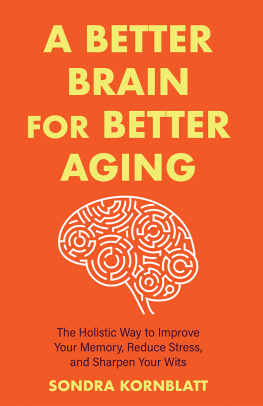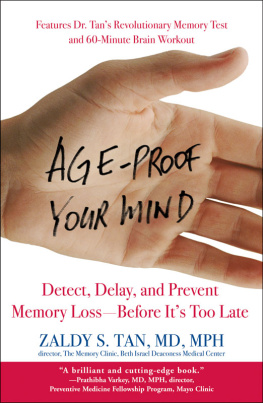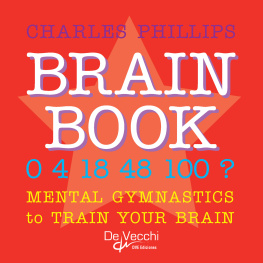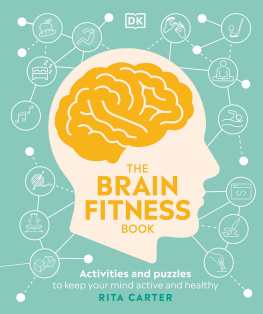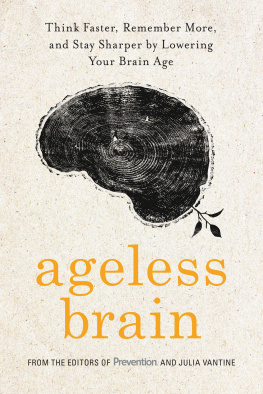KEEP YOUR
BRAIN ALIVE
____________________
83 Neurobic Exercises
to Help Prevent Memory Loss and
Increase Mental Fitness

Lawrence C. Katz, Ph.D.
& Manning Rubin
Illustrations by David Suter
Workman Publishing Company, New York
Copyright 1999 by Lawrence C. Katz and Manning Rubin
Illustrations copyright David Suter
Cover and book design: Elaine Tom
All rights reserved. No portion of this book may be reproducedmechanically,
electronically, or by any other means, including photocopyingwithout
written permission of the publisher. Published simultaneously in
Canada by Thomas Allen & Son Limited.
Library of Congress Cataloging-in-Publication Data
Katz, Lawrence C., 1956
Keep your brain alive: 83 neurobic exercises to help prevent memory loss and
increase mental fitness/by Lawrence C. Katz and Manning Rubin.
p. cm.
eISBN 978-0-7611-6433-3
1. CognitionAge factors. 2. CognitionProblems, exercises, etc. 3. MemoryAge
factors. 4. CognitionProblems, exercises, etc. 5. AgingPsychological aspects.
I. Rubin, Manning. II. Title.
BF724.55.C63K38 1999
153dc21 99-18888
CIP
Workman books are available at special discounts when purchased in bulk
for premiums and sales promotions as well as for fund-raising or educational use.
Special editions or book excerpts can also be created to specification.
For details, contact the Special Sales Director at the address below.
Workman Publishing Company, Inc.
225 Varick Street
New York, NY 10014-4381
ACKNOWLEDGMENTS
We both thank Peter Workman for being our match-maker, and our editor, Ruth Sullivan, for her steadfast faith in the project and her relentless pursuit of clarity and simplicity in the writing and organization of the material.
Larry Katz wishes to thank Doris Iarovici, his spouse, for her critical insights, advice, and editorial assistance, and Bonnie Kissell, for unflagging administrative support of this project.
Manning Rubin thanks Jane Rubin, for bearing the brunt of his burying himself in the research, writing, and rewriting he has been obsessed with for two years, and for her level-headed observations that helped the book. And he thanks Larry for the voluminous work he has produced in keeping this book alive.
CONTENTS
CHAPTER I
Neurobics: The New Science of Brain Exercise
CHAPTER II
How the Brain Works
CHAPTER III
How Neurobics Works
CHAPTER IV
Starting and Ending the Day
CHAPTER V
Commuting
CHAPTER VI
At Work
CHAPTER VII
At the Market
CHAPTER VIII
At Mealtimes
CHAPTER IX
At Leisure
PREFACE
As the population of over 76 million Baby Boomers approaches middle age and beyond, the issue of preserving mental powers throughout greatly increased life spans has reached an almost fever pitch. There is a growing interest inand optimism aboutpreserving and enhancing the brains capabilities into senior years. With the help of powerful new tools of molecular biology and brain imaging, neuro-scientists around the world have literally been looking into the mind as it thinks. Almost daily, they are discovering that many of the negative myths about the aging brain are, indeed, only myths: Older and wiser is not just a hopeful clich but can be the reality. In much the same way that you can maintain your physical well-being, you can take charge of your mental health and fitness.
Although new and therefore not yet proved by a large body of tests, Neurobics is based on solid scientific ground; it is an exciting synthesis of substantial findings about the brain that provides a concrete strategy for keeping the brain fit and flexible as you grow older.
From Theory to Practice

Jane reached into her pocketbook and fished inside for the keys to her apartment. Usually they were in the outside flap pocket but not today. Did I forget them?! Nohere they are. She felt their shapes to figure out which one would open the top lock. It took her two tries until she heard the welcome click of the lock opening. Inside the door she reached to the left for the light switchbut why bother? Her husband would do that later. Touching the wall lightly with her fingertips, she moved to the closet on the right, found it, and hung up her coat. She turned slowly and visualized in her mind the location of the table holding her telephone and answering machine. Carefully she headed in that direction, guided by the feel of the leather armchair and the scent of a vase of birthday roses, anxious to avoid the sharp edge of the coffee table and hoping to have some messages from her family waiting.
The table. The answering machine. She reached out and brushed her fingers across what she believed to be the play button. What if I push the delete button? she thought, and again checked to make sure she was right. Yesterday it was so easy. She could havedone all this simply by looking around. Today was different. She could see nothing.
But Jane had not suddenly gone blind. At age 50, she was introducing a lifestyle strategy called Neurobics into her daily activities. Based on recent discoveries in brain science, Neurobics is a new form of brain exercise designed to help keep the brain agile and healthy. By breaking her usual homecoming routine, Jane had placed her brains attentional circuits in high gear. With her eyes closed, she had to rely on her senses of touch, smell, hearing, and spatial memory to do something they rarely didnavigate through her apartment. And she was involving her emotional sense by feeling the stresses of not being able to see. All these actions created new and different patterns of neuron activity in her brainwhich is how Neurobics works.
This book will explain the principles behind Neurobics and how the exercises enhance the overall health of your brain as you grow older.
Chapter I
Neurobics: The New Science of Brain Exercise
What was the name of that actor who was in all the early Woody Allen films? You knowcurly brown hair?
The first time you forget the name of a person you should know, a movie title, or an important meeting, youre likely to exclaimonly half-jokinglyIm losing it! My brain is turning to Jell-O. Reinforced by messages and images in the mass media, you equate mild forgetfulness with the first stages of accelerating mental decline.
He was just in a Broadway show with, um, whats-her-name. Oh, God, you know who I mean.
And maybe they do. But if they dont, you become frustrated and preoccupied trying to recall this buried name. Usually beginning in your forties or fiftiessometimes even in your thirtiesyou start to notice these small lapses: not remembering where you put the car keys or what was on the grocery list you left at homeor being unable to understand the instructions for a new VCR or computeror forgetting where the car is parked because you left the mall through a different door.
Even though these small lapses dont actually interfere much with daily life, the anxiety they provoke can. You worry that youll become just like your Aunt Harriet, who can remember details of events from the Depression but not what she did yesterday. Firsthand experiences with people who have difficulty with perception and memory as they age can make you anxious when you suddenly forget something ordinary. No wonder you jump to the conclusion that aging is an inevitable slide into forgetfulness, confusion, or even the first stages of Alzheimers disease.


